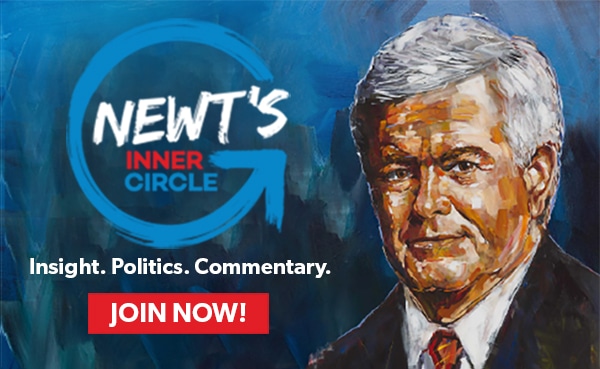If you are determined to be an American majority, and you are committed to listening to and learning from the American people.
by Newt Gingrich
The Contract with America became famous because it was the centerpiece of the House Republican campaign, which won a majority for the first time in 40 years.
As I mentioned in part two of this series, the Contract campaign stood on President Ronald Reagan’s shoulders.
The Contract’s Capitol Steps rally of candidates was modeled after the one with Reagan in September 1980. We knew it would draw media attention – because we had already done it.
In fact, Reagan himself had described a contract at that 1980 event saying, “This occasion marks the first time that legislative and executive candidates of a party have come together to propose a contract with the American people. But the times demand a unique response: For too long, government has been distant and uncaring, now we must return government to the people.”
The Contract was written with an understanding that nothing that was supported by fewer than 60 percent of the American people could be included. Ideally, we were aiming to only include issues with 70 percent support or more. By definition, that meant we were writing a bipartisan document that appealed far beyond the Republican base.
Finally, most of the specifics in the Contract grew straight out of President Reagan’s policies. For example, candidate Reagan had advocated a work-oriented welfare reform in his first race for governor in 1966. We finally passed it into law in 1996 (and it became the most successful conservative reform of our lifetime).
We added one other rule to our development of the Contract. We knew that the news media was our active opponent (many of its members had worked as Democratic staffers previously). So, we insisted that some of our favorite conservative issues (specifically, right to life and school prayer) would not be included in the Contract. If we had included them, The New York Times and others would focus solely only on those issues and the rest of our agenda would be buried. This was a tough decision, because I am strongly pro-life and believe America would be much better off with prayer back in school. However, looking back, it was the right move because the media would have totally ignored all the strong points of the Contract and distorted it as a narrow, southern, right-wing document.
The biggest misunderstanding about the Contract was its bipartisan nature. The news media had to find an explanation for our stunning victory after four decades in the minority, and left-wing pundits could not blame the arrogance, corruption and failures of their friends in the Democratic Party. Therefore, they had to blame me – and interpret our victory as narrowly partisan.
However, note how the Contract was framed in a speech on the House floor on Sept. 22, 1994, a week before the Capitol Steps signing ceremony:
“There is not a negative word here about the Democratic Party. There is not a negative word here about President Clinton and his administration. It is an effort on our part to be positive.
“You might say, why are we being positive about this? I think that there are two very profound reasons why it would be good to have a positive campaign in October 1994, rather than a negative campaign.
“The first reason is that people are so frustrated, people are so hostile, people are so angry, that you do not need to go out and get them madder. You don’t have to go out and beat up on President Clinton or beat up on the Congress. People get it. They are already fed up.
“What people want to know, I think, is what are you going to do differently? Our challenge to the Democrats is if they do not like our 10 bills, what are theirs? If they do not like our three reforms, what are theirs? Let us have a debate between ideas, but let us not have the kind of negative smear tactics that have driven the country, I think, to distraction, and have broken down any willingness to have a decent political debate.
“We are prepared to debate on the issues: Is it a good idea to have a balanced budget amendment, a line-item veto, or not? Is it a good idea to have an effective, believable, and timely death penalty for violent offenders, or not? Should we encourage work and family in the welfare system, or not?
“These are real policy proposals. We are going to have next Tuesday a whole set of bills.
“All 10 bills are already going to be written and available.
“There is a second reason, I would argue, why it would be good to actually try to have a debate in October on the issues. I think this country is in trouble. People have talked about the economic recovery and all this stuff. Nonsense. The underlying core pattern of where America is at is real trouble.
“If you do not believe me, watch any major city local television news, including Washington, for two nights. The child abuse, the rape, the murders, the cocaine dealing, the problems of American life are unbelievable. I am a history teacher, and I tell every audience that as a matter of history, not politics, as a matter of history, it is impossible to maintain American civilization with 12-year-olds having babies, 15-year-olds killing each other, 17-year-olds dying of AIDS, and 18-year-olds getting diplomas they cannot read. I don’t think that is debatable. I think it is clear.”
My speech has modeled on Reagan’s statement on the Capitol Steps 14 years earlier. He said: “Speaking personally, I can remember the many times in California when I reached out to members of the other party in order to pass important legislation. I know that all of us here today, as a team, will also seek close cooperation with the other side throughout our terms.”
The bipartisan appeal of the Contract with America can be seen in the voting pattern on the House floor.
The specific Contract items averaged getting 63 Democrats voting with the House Republicans. I know this is the opposite of the news media mythology, so don’t take my word for it. Here are the key votes in 1995:
- H.R. 1, “Congressional Accountability Act of 1995” – 228 Republicans and 200 Democrats voted yea. 0 nay votes. 1 Independent voted yea, 4 Members not voting.
- H.R. 2, “Line Item Veto Act” – 223 Republicans and 71 Democrats voted yea. 4 Republicans voted yea, 129 Democrats voted nay. 1 Independent voted nay, 7 Members not voting.
- • H.R. 3, “Taking Back Our Streets Act of 1995.” The House passed elements of this package in:
-
- H.R. 666, “Exclusionary Rule Reform Act” – 220 Republicans and 69 Democrats voted yea, 7 Republicans and 134 Democrats voted nay. 1 Independent nay, 3 Members Not Voting;
- H.R. 729, “Effective Death Penalty Act” – 226 Republicans and 71 Democrats voted yea, 1 Republican and 130 Democrats voted nay. 1 Independent nay, 5 Members not voting;
- H.R. 667, “Violent Criminal Incarceration Act” – 206 Republicans and 59 Democrats voted yea, 20 Democrats and 135 Republicans voted nay. 1 Independent nay, 13 Members not voting;
- H.R. 728, “Local Government Law Enforcement Block Grants Act” – 220 Republicans and 18 Democrats voted yea, 9 Republicans and 182 Democrats voted nay. 1 Independent nay, 5 Members not voting.
- H.R. 4, “Personal Responsibility Act of 1995”(Welfare reform) – 225 Republicans and 9 Democrats voted yea, 5 Republicans and 193 Democrats voted nay. 1 Independent voted nay, 2 Members not voting.
- H.R 5, “Unfunded Mandate Reform Act” – 230 Republicans and 130 Democrats voted yea, 73 Democrats voted nay. 1 Independent voted nay, 1 Member not voting.
- H.R. 6, “American Dream Restoration Act” – passed as part of H.R. 1215, “Contract With America Tax Relief Act” – 219 Republicans and 27 Democrats voted yea, 11 Republicans and 176 Democrats voted nay. 1 Independent voted nay, 1 Member not voting.
- H.R. 7, “National Security Revitalization Act” – 223 Republicans and 18 Democrats voted yea, 4 Republicans and 176 Democrats voted nay. 1 Independent voted nay, 13 Members not voting.
- H.R. 8, “Senior Citizens’ Equity Act” – also passed as part of H.R. 1215 noted above.
- H.R. 9, “Job Creation and Wage Enhancement Act of 1995” – 219 Republicans and 58 Democrats voted yea, 8 Republicans and 132 Democrats voted nay. 1 Independent voted nay, 17 Members not voting.
- H.R. 10, “Securities Litigation Reform Act” – elements passed in H.R. 1058, “Private Securities Litigation Reform Act of 1995.” 226 Republicans and 99 Democrats voted yea, 0 Republicans and 98 Democrats voted nay. 1 Independent nay, 1 Present vote, 10 Members not voting.
- H.J.Res.1, “Proposing a balanced budget amendment to the Constitution of the United States,” – 228 Republican and 72 Democratic yea, 2 Republican and 129 Democratic nays. 1 Independent nay, 3 Not Voting. Passed 2/3 by a total vote of 300 to 132.
- H.J.Res.73, “Proposing an amendment to the Constitution of the United States with respect to the number of terms of office of Members of the Senate and the House of Representatives” – 189 Republican and 38 Democratic yea, 40 Republican and 163 Democratic nay. 1 Independent nay; 1 Present and 3 Not Voting. Total vote of 227 to 204 failed to reach 2/3 required.
Our bipartisan, American majority approach enabled House Republicans to survive the 1996 loss of the presidential campaign – and retain the majority for the first time since 1928. The American people endorsed the positive attitude, positive reforms, and focus on an American rather than a Republican agenda.
The ability to legislate with a bipartisan majority continued in 1997, when we moved to balance the federal budget (which succeeded in balancing for four years for the only time in your lifetime).
When we initially passed H.R. 2015 – Balanced Budget Act of 1997, the initial vote was 270 – 162 (with 219 Republicans and 51 Democrats voting yes and 154 Democrats, 7 Republicans and 1 independent voting no).
When the final balanced budget conference report came up, it passed by a vote of 346-85 (with 193 Republicans and 153 Democrats voting for the measure and 32 Republicans, 52 Democrats, and 1 Independent voting against it).
We had achieved this line of bipartisan majorities for conservative reforms because we had followed the lesson of President Reagan and the strategies he had learned at General Electric.
If you are determined to be an American majority, and you are committed to listening to and learning from the American people, it is amazing how much the grassroots will help you legislate in a bipartisan way.

Newt’s Latest Articles:
- Biden and the ‘Blame America First’ Democrats
- Communist China Claims All Pandas in the World, Which Illuminates a Larger Story
- The American People vs. Judicial Corruption
- Bidenomics – Inflation Persists and Jobs Decay
- Biden and Democrats Forced No Labels To Skip 2024 Race, and RFK Jr. Is Next on Their List
Newt’s Latest Podcasts:
- Newt’s World – Episode 685: Welfare Reform

- Newt’s World – Episode 684: Funding the War in Ukraine

- Newt’s World – Episode 683: Student Loan Debt Forgiveness

- Newt’s World – Episode 682: Ukraine’s War of Independence

- Newt’s World – Episode 681: How Happy Are We?

Get Newt’s Latest Book:








